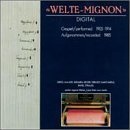
Claude Debussy, Edvard Grieg, Gustav Mahler, Maurice Ravel and Max Reger Welte-Mignon Digital, Performed 1905-1914 (by the original composers) Music
by Claude Debussy, Edvard Grieg, Gustav Mahler, Maurice Ravel and Max Reger
Music Comments & Discussion

Welte-Mignon Digital, was the world's first real digital instrument - patented in Germany on 25.09.1905, as the first self-playing piano.
This CD is a DDD recording of the actual composers playing their own works, performed 1905-1914 on a special 'recording piano', which recorded the keys pressed on a paper tape. These paper tapes could then be copied and sold as the first DIGITAL MUSIC to be used in the company's self-playing pianos and later also organs!
The firm was already famous for its inventions in the field of the reproduction of music when Welte introduced the Welte-Mignon reproducing piano in 1904, which came onto the market in 1905. As a result of this invention by Edwin Welte and his brother-in-law Karl Bockisch, one could now record and reproduce the music played by a pianist as true to life as was technologically possible at the time.
From 1912 on, a similar system for organs branded "Welte Philharmonic-Organ" was produced. Thirteen well-known European organist-composers of the era, among them Alfred Hollins, Eugene Gigout and Max Reger were photographed recording for the organ, distinguished organists like Edwin Lemare, Clarence Eddy and Joseph Bonnet were recorded too.
From 1919 on, Welte built also theatre organs. With the introduction of "talkies" around 1927, this need began to also diminish and by 1931 production of these instruments was severely curtailed. The last big theatre organ was a custom built instrument for the Norddeutscher Rundfunk (NDR, North German Broadcasting) studio in Hamburg, still in place and still playing. Some other theatre organs of Welte are today in museums. One of these organs can be seen in the Scotty's Castle museum in Death Valley where is it played regularly during museum tours.
At least one of there instruments went down with the Titanic.
Background:
The Welte Company was a German firm, first established in 1832 at Vöhrenbach (Black-
Forest) by automata manufacturer Michael Welte (1807-1880). In about 1865 he moved to
Freiburg/Breisgau and registered there as M. Welte & Söhne. During the remainder of the 19th
century the firm expanded considerably and became particularly noted for its orchestrions. In
1904 Edwin Welte (1876-1958, grandson of the founder) invented the Vorsetzer, and from
that the famous Welte-Mignon player-piano was developed, appearing on the market in 1905.
This rather arcane piano technology was adapted to the "Welte-Philharmonie-Orgel" (known
as the “Philharmonic” in the USA). By 1909 a recording organ had been built for Welte’s
studios in Freiburg. The Philharmonie was displayed in November 1911 at the Turin
Exhibition in Italy. Welte successfully went on to market player organs, cinema organs,
cinema player organs and, later, when that market contracted during the 1930s, church organs.
They issued punched paper roll recordings dated between 1912 and 1930 of performances by
the great organists of the day and sold them with considerable commercial success. From
1865-1917 they also ran a branch in New York (M. Welte & Sons) under Emil Welte (1841-
1923, eldest son of the founder) but it was closed during World War I as an "alien enterprise".
This CD recording is a real MARVEL!!
When I first bought it I could not get enough of Max Reger's style of playing.
This CD is a DDD recording of the actual composers playing their own works, performed 1905-1914 on a special 'recording piano', which recorded the keys pressed on a paper tape. These paper tapes could then be copied and sold as the first DIGITAL MUSIC to be used in the company's self-playing pianos and later also organs!
The firm was already famous for its inventions in the field of the reproduction of music when Welte introduced the Welte-Mignon reproducing piano in 1904, which came onto the market in 1905. As a result of this invention by Edwin Welte and his brother-in-law Karl Bockisch, one could now record and reproduce the music played by a pianist as true to life as was technologically possible at the time.
From 1912 on, a similar system for organs branded "Welte Philharmonic-Organ" was produced. Thirteen well-known European organist-composers of the era, among them Alfred Hollins, Eugene Gigout and Max Reger were photographed recording for the organ, distinguished organists like Edwin Lemare, Clarence Eddy and Joseph Bonnet were recorded too.
From 1919 on, Welte built also theatre organs. With the introduction of "talkies" around 1927, this need began to also diminish and by 1931 production of these instruments was severely curtailed. The last big theatre organ was a custom built instrument for the Norddeutscher Rundfunk (NDR, North German Broadcasting) studio in Hamburg, still in place and still playing. Some other theatre organs of Welte are today in museums. One of these organs can be seen in the Scotty's Castle museum in Death Valley where is it played regularly during museum tours.
At least one of there instruments went down with the Titanic.
Background:
The Welte Company was a German firm, first established in 1832 at Vöhrenbach (Black-
Forest) by automata manufacturer Michael Welte (1807-1880). In about 1865 he moved to
Freiburg/Breisgau and registered there as M. Welte & Söhne. During the remainder of the 19th
century the firm expanded considerably and became particularly noted for its orchestrions. In
1904 Edwin Welte (1876-1958, grandson of the founder) invented the Vorsetzer, and from
that the famous Welte-Mignon player-piano was developed, appearing on the market in 1905.
This rather arcane piano technology was adapted to the "Welte-Philharmonie-Orgel" (known
as the “Philharmonic” in the USA). By 1909 a recording organ had been built for Welte’s
studios in Freiburg. The Philharmonie was displayed in November 1911 at the Turin
Exhibition in Italy. Welte successfully went on to market player organs, cinema organs,
cinema player organs and, later, when that market contracted during the 1930s, church organs.
They issued punched paper roll recordings dated between 1912 and 1930 of performances by
the great organists of the day and sold them with considerable commercial success. From
1865-1917 they also ran a branch in New York (M. Welte & Sons) under Emil Welte (1841-
1923, eldest son of the founder) but it was closed during World War I as an "alien enterprise".
This CD recording is a real MARVEL!!
When I first bought it I could not get enough of Max Reger's style of playing.
Post Comment - Let others know what you think about this Music
The above Music needs a Video (from youtube)
You can add a video of the above Music from youtube:Click here to Add »
Report Abuse for this page, if inappropiate
Music on the site is added by members. You can add Music too. Click here to add one.
 Joyce Cooling: Marina's dream
Joyce Cooling: Marina's dream Blue: One Love
Blue: One Love Meghan Trainor: Better When Im dancing
Meghan Trainor: Better When Im dancing Four play: I"ll still be lovin you
Four play: I"ll still be lovin you Shah: Love you
Shah: Love you